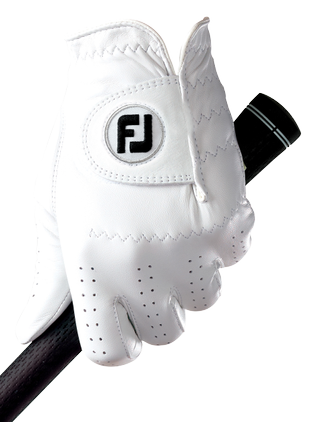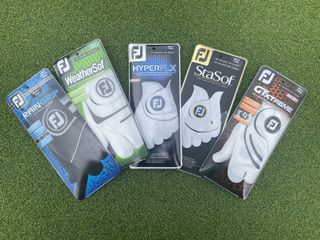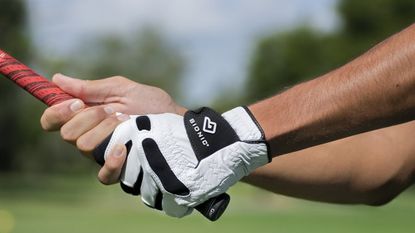Gloves are a vastly under-rated golfing accessory. On a scale of importance you could make a reasonable argument that a glove is behind only a putter and a bag. A bold claim, admittedly, but hear me out.
If push comes to shove, you can get by without many golf 'essentials', but trying to play golf without a pair of the best golf gloves is really difficult if you are accustomed to wearing one. Turning up the course without a glove gives you that same sense of sheer panic as leaving the house and realising you don't have your phone.
For the overwhelming majority of people, playing golf with a glove is considerably easier than playing without one. Yet many amateurs are more than willing to spend big money on clubs, the best golf watch, laser range finders, the best golf shoes etc but will baulk at the idea of splashing the cash on a glove. You will often see amateur golfers sporting a battered old dirty glove while pushing a fancy electric trolley containing a brand new set of irons and the best driver on the market. So yeah, the importance of a golf glove is under-rated.
Gloves are not compulsory of course and there have been some top professionals who did not wear one, most notably Ben Hogan and Fred Couples, as well as 2009 US Open winner Lucas Glover, ironically. However, the overwhelming majority of golfers will wear a glove and some may even elect to go with a glove on both hands, although that is quite rare – and for some reason looks REALLY weird.
Non-golfers will often question the use of only one glove, or indeed the need for any glove at all, but there are two very good reasons for wearing a glove when playing golf. Primarily, it gives you a nice, secure grip on the club, which is obviously important as the last thing you want is for your club to go further down the fairway than the ball!
Ok, that’s an extreme example and rarely happens, but on a more practical note the extra friction a glove provides can prevent the club from moving around in your hand and will therefore help you play more consistently.
Additionally, it will protect your hand from wear and tear. If you play a lot of golf you will get callouses on your hands and if you don’t play often it will be even worse because that can result in blisters and abrasions. This is a problem when you haven’t played in a while, for example your first practice session in the spring after shutting it down over winter. Basically a glove offers grip and protection, both of which make the game easier.
On which hand should you wear a glove?

Golfers wear a glove on their lead hand, which for right handed players means the left hand and vice versa for lefties. This is because in the golf swing it is the weaker hand that actually does most of the work, assuming of course that you play with clubs that match your strong hand, which not everybody does.
The great Phil Mickelson would be the most high profile exception to that rule. “Lefty”, as he is affectionately referred to, is in fact right handed but has always played with left handed clubs since he first took up the game as a small child.
That is rare though and most golfers will have clubs that match their dominant hand, meaning the glove is worn on their weak hand because it is essential to keep a secure hold of the club throughout the swing and, as already stated, it’s the weaker hand that does the heavy lifting in a golf swing. The strong hand provides guidance through the shot but the weak hand controls the strike and provides the power.
Therefore a secure hold on the club is essential and although you can achieve that with a bare hand, gripping the club too tightly can cause inconsistency in your ball striking. Without a glove you are more likely to grip the club too tight, whereas a glove allows you to keep a secure hold on the club without having to squeeze it too tightly.
- Golf Bags - Is stand, cart, tour or carry best for you?
- Golf Waterproofs - What to look for when buying
Which shots require a glove?
This is entirely subjective but for the most part you will see golfers wearing a glove on full shots and then removing it on the putting green. This is because on a full golf shot a secure grip is essential, but putting is much more about feel and there is no danger of the club slipping from your grasp.
There is nothing in the rules to say you can’t wear your glove while putting but it is quite an unusual sight, both in the professional game as well as on your local course. Whether club golfers remove the glove because they’ve seen the pros do it or just because it’s more comfortable is an interesting question, but the fact is most golfers take off their glove when on the green.
An added benefit of removing the glove on the green is that it allows your skin to breathe which will reduce sweating. If you kept a glove on four hours straight you’d be having it to peel it off like a wet swimsuit by the time you’d finished your round! So taking it off for putting, or even in between shots too, is advisable.
The grey area would be chipping, which is not a full shot but requires more of a firm grip than putting. Feel is especially important when it comes to chipping and a glove can hinder that in some cases, but the majority of golfers would still wear a glove for chipping and bunker shots. Ultimately though it just comes down to personal preference.
Does more expensive mean better performance?

Do more expensive gloves perform better? Kind of, but it depends on how you define performance. As with most things, the more expensive items tend to be priced that way because they are higher quality. However, a fancy golf glove will not give you a better chance of shooting a lower score than a basic golf glove will.
Your choice of glove will not make any difference to your score, at least not in normal weather conditions. A wet weather glove (see above photo) will certainly perform better in the rain than a normal glove. It will help you keep a firm grip on your club throughout your swing even in a heavy downpour because they are specifically designed to provide extra grip when wet.
Many standard gloves become a little slippy when they get wet so that is probably the only situation when a specific kind of glove can translate to better scoring.
When it comes to a higher priced glove you are paying for luxury, comfort and (in some cases) longevity more than any noticeable increase in performance. Expensive gloves are made from softer materials and they feel nicer to the touch. Some of them will react to moisture and perform even better when your hand perspires.
Most golf gloves are made from leather as it provides great feel and acts like a second skin. Leather is also moisture resistant. It will hold water on a wet day but will suffer no ill effects afterwards if you pull it back to shape and allow it dry naturally. In other words, don’t leave it scrunched up in your golf bag when it’s wet!
Some gloves use synthetic material on certain parts of the knuckles or fingers to provide more flexibility. You can also get gloves that are 100% synthetic and these will be more durable and last longer than a leather alternative. They perform well in warm weather as they help to keep the hand cool.
Spending more on a high priced glove is not going to make you hit better shots than you would with a standard glove but then that’s the same with shoes and polo shirts too. A £100 shirt won’t make you play better than a £30 one, but you might feel better about yourself and that could lead to more self confidence. Really though you are paying for the quality of material and the styling.
How often do you need to replace your glove?

This depends entirely on the quality of the glove. Some are going to be more durable than others and a cheaper glove generally will not last as long. Depending on the quality of leather used it may lose its shape and become a bit stiff, especially after getting wet.
If your glove does get wet then the best thing to do after your round is to let it dry naturally at room temperature or outside. Do not put it on a radiator or sit it in front of the fire as it will end up like a crumpled piece of cardboard!
If you have bought an expensive glove then, as recommended above, don’t use that on the range as that is pointless. Have a cheaper glove for practice and keep the better quality one in your bag and use it only on the course. That will prolong its shelf life and you should not need to replace it for a good while.
It is a useful idea to have more than one glove with you on the course in case of rain, or on extremely hot days when you may want to change due to sweating. Professionals will change gloves two or three times every round but that’s easy for them as they aren’t having to pay for them! Generally one glove will get you through a round but it is prudent to have a spare just in case.
Wear and tear on your glove can indicate a flawed grip. If your glove is wearing away on the palm (see above photo) that is because the grip of the club runs from your index finger across the palm of your hand. This is a common fault in many mid-high handicap golfers, and ideally you want to grip the club across the base of your fingers - not in your palm - as this helps consistency and increases power. It will also ensure you get much more mileage out of your glove.
So what should you buy?

When buying a glove you can’t go wrong with any of the major golf brands such as Footjoy, Wilson Staff, Srixon, Under Armour, Callaway, Ping etc but if you require any help then worry not, we have compiled this handy best golf gloves buying guide for you.
You don’t need to buy the most expensive one to be able to play golf as a standard glove will do you just fine (be warned though, you may need to replace that more quickly than you will with a higher quality option) but you might want to also have a wet weather glove in the bag for when you get caught in a downpour.
If you are someone who spends quite a bit of time at the driving range then it would be prudent to use cheaper gloves for practice and then have a nice, soft feeling glove for when you get out on the course.
Sizing is extremely important as you need it to fit snugly. Many golfers wear a glove that is too big for them. You don’t want it too tight but equally it can’t be loose either. You need a glove that fits your hand like… well, like a glove. It should feel like a second skin with no excess material across the palm or at the end of the fingers.
Sizes are as you’d expect, small, medium, large and extra large and those are available in men, women and children’s sizes. In the men’s sizes you also have a medium large (ML) option as the majority of men are between a medium and a large.
So try before you buy, as the way golf gloves are packaged these days makes it easy to just pop the glove out and try it on to ensure you have the correct size.



